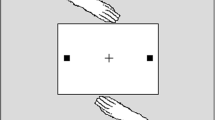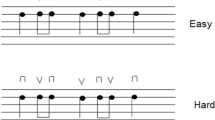Abstract
Ideomotor movements may arise in individuals while they watch goal-directed actions or events. In a previous study we developed a paradigm for investigating ideomotor movements induced through watching the outcome of one’s own action. In the present study we extended the paradigm to investigate both movements induced through watching the outcome of one’s own as well as somebody else’s action (player mode and observer mode respectively). We report three experiments, each with differing conditions for the player mode, but identical conditions for the observer mode. Results indicate that in both modes ideomotor movements are governed by two basic principles: Perceptual induction and intentional induction. In the player mode we replicated and extended previous findings, indicating dissociation between hand and head movements. In the observer mode no such dissociation was obtained. Our findings suggest that people perform, in their own actions, what they see being performed in other people’s actions. Induction of action through observation can pertain to both the action’s physical surface and underlying intentions. Furthermore, our results suggest that perceptual induction is ubiquitous but may be locally suspended for intentional action control. We discuss our results in the framework of theories invoking a strong overlap between representational structures for action perception and action planning.








Similar content being viewed by others
Notes
It may also be expected that ideomotor movements would be, in general, weaker and/or less frequent in monitoring the actions of others vs. self-performed actions (tracking vs. bowling). However, since the two tasks are quite different in their basic functional requirements, we believe that comparisons of absolute magnitudes of induced movements (i.e., main effects) do not make much sense. However, this argument does not affect comparisons of magnitudes of differences (i.e., interactions).
Randomized sequences of 192 event configurations from the bowling task were prepared as stimuli for each of the two conditions of the tracking task. These bowling patterns had actually been recorded from players’ performance in previous experiments. Depending on the task condition they showed initial corrective interventions either on the ball or the target. As in the bowling task, the sequences of 192 bowling patterns consisted of four replications of the 48 possible trajectories. Furthermore, these patterns exhibited an equal number of hits, left misses, and right misses (one-third each).
As is illustrated in Fig. 3 the beginning was set at the true onset of that period (0%), whereas the end was set at 80%. This latter point was chosen because pilot studies and earlier experiments had shown that in the very final phase of the induction period, induced movements may often be confounded with reset movements, i.e., movements that go back to the effector’s original default position (cf. Knuf et al., 2001, p. 787).
The application of the 200-ms standstill criterion could have one of two consequences, depending on whether or not a sufficiently long standstill was observed during the induction period of a trial. If there was no standstill of sufficient length, the trial was discarded. If there was a standstill of sufficient length, effective NIS values were computed from the net shift arising between the end of the standstill period and the 80% line. These effective NIS values were entered into the ANOVAs to be performed.
References
Bargh, J. A. (1997). The automaticity of everyday life. In R. S. Wyer, Jr. (Ed.), Advances in social cognition (Vol. 10, pp. 1–61). Mahwah, NJ: Erlbaum.
Bargh, J. A., & Barndollar, K. (1996). Automaticity in action: The unconscious as repository of chronic goals and motives. In P. M. Gollwitzer & J. A. Bargh (Eds.), The psychology of action: Linking cognition and motivation to behavior (pp. 457–481). New York: Guilford.
Carpenter, W. B. (1874). Principles of mental physiology, with their applications to the training and discipline of the mind and the study of its morbid conditions. New York: Appleton.
Chevreul, M. E. (1833). Lettre à M. Ampère sur une classe particulière de mouvements musculaires. Revue des Deux Mondes, II, 258–266.
Csibra, G., & Gergely, G. (1998). The teleological origins of mentalistic action explanations: A developmental hypothesis. Developmental Science, 1, 255–259.
Csibra, G., Gergely, G., Biró, S., Koós, O., & Brockbank, M. (1999). Goal attribution without agency cues: The perception of “pure reason” in infancy. Cognition, 72, 237–267.
Decety, J., Grèzes, J., Costes, N., Perani, D., Jeannerod, M., Procyk, E., et al. (1997). Brain activity during observation of actions: Influence of action content and subject’s strategy. Brain, 120, 1763–1777.
Fadiga, L., Fogassi, L., Pavesi, G., & Rizzolatti, G. (1995). Motor facilitation during action observation: A magnetic stimulation study. Journal of Neurophysiology, 73, 2608–2611.
Gallese, V., Fadiga, L., Fogassi, L., & Rizzolatti, G. (1996). Action recognition in the premotor cortex. Brain, 119, 593–609.
Gallese, V., Fadiga, L., Fogassi, L., & Rizzolatti, G. (2002). Action representation and the inferior parietal lobule. In W. Prinz & B. Hommel (Eds.), Attention and Performance, Vol. XIX: Common mechanisms in perception and action (pp. 334–355). Oxford: Oxford University Press.
Grafton, S. T., Arbib, M. A., Fadiga, L., & Rizzolatti, G. (1996). Localization of grasp representations in humans by PET: 2. Observation compared with imagination. Experimental Brain Research, 112, 103–111.
Greenwald, A. G. (1970). Sensory feedback mechanism in performance control: With special reference to the ideomotor mechanism. Psychological Review, 77, 73–99.
Greenwald, A. G. (1972). On doing two things at once: Time sharing as a function of ideomotor compatibility. Journal of Experimental Psychology, 94, 52–57.
Heider, F. (1926/1959). Thing and medium. Psychological Issues, 1959, Monograph 3 (pp. 1–34). [Original work published 1926.]
Heider, F. (1930/1959). The function of the perceptual system. Psychological Issues, 1959, Monograph 3 (pp. 35–52). [Original work published 1930.]
Heider, F., & Simmel, M. (1944). An experimental study of apparent behavior. American Journal of Psychology, 57, 243–259.
Hommel, B., Müsseler, J., Aschersleben, G., & Prinz, W. (2001). A theory of event coding (TEC): A framework for perception and action planning. BBS—Behavioral and Brain Sciences, 24, 849–937.
Iacoboni, M., Woods, R. P., Braß, M., Bekkering, H., Mazziotta, J. C., & Rizzolatti, G. (1999). Cortical mechanisms of human imitation. Science, 286, 2526–2528.
James, W. (1890). The principles of psychology (Vols. 1 & 2). New York: Holt.
Jellema, T., & Perrett, D. I. (2002). Coding of visible and hidden actions. In W. Prinz & B. Hommel (Eds.), Attention and Performance, Vol. XIX: Common mechanisms in perception and action (pp. 356–380). Oxford: Oxford University Press.
Jellema, T., Baker, C. I., Perrett, D. I., & Wicker, B. (2000). Neural representation for the perception of the intentionality of actions. International Journal of Psychology, 35, 205.
Jovanovic, B., Király, I., Elsner, B., Gergely, G., Prinz, W., & Aschersleben, G. (2003). The role of effects for infants’ perception of action goals. Manuscript in preparation.
Katz, D. (1960). Sozialpsychologie. In D. Katz & R. Katz (Eds.), Handbuch der Psychologie. Basel, Switzerland: Schwabe.
Knuf, L., Aschersleben, G., & Prinz, W. (2001). An analysis of ideomotor action. Journal of Experimental Psychology: General, 130, 779–798.
Lotze, R. H. (1852). Medizinische Psychologie oder Physiologie der Seele [Medical psychology or mental physiology]. Leipzig, Germany: Weidmann’sche Buchhandlung.
Nishitani, N., & Hari, R. (2000). Temporal dynamics of cortical representation for action. Proceedings of the National Academy of Science USA, 97, 913–918.
Perrett, D. I., Harries, M. H., Bevan, R., Thomas, S., Benson, P. J., Mistlin, A. J., et al. (1989). Frameworks of analysis for the neural representation of animate objects and actions. Journal of Experimental Biology, 146, 87–113.
Perrett, D. I., Harries, M. H., Mistlin, A. J., Hietänen, J. K., Benson, P. J., Bevan, R., et al. (1990). Social signals analysed at the single cell level: Someone is looking at me, something touched me, something moved. International Journal of Comparative Psychology, 4, 25–50.
Prinz, W. (1987). Ideomotor action. In H. Heuer & A. F. Sanders (Eds.), Perspectives on perception and action (pp. 47–73). Hillsdale, NJ: Erlbaum.
Prinz, W. (1990). A common-coding approach to perception and action. In O. Neumann & W. Prinz (Eds.), Relationships between perception and action: Current approaches (pp. 167–201). Berlin Heidelberg New York: Springer.
Prinz, W. (1997). Perception and action planning. European Journal of Cognitive Psychology, 9, 129–154.
Prinz, W. (2002). Experimental approaches to imitation. In A. Meltzoff & W. Prinz (Eds.), The imitative mind: Development, evolution, and brain bases (pp. 143–162). Cambridge, UK: Cambridge University Press.
Prinz, W., De Maeght, S., & Knuf, L. (in press). Intention in action. In G. Humphreys & J. Riddoch (Eds.), Attention in action: Advances from Cognitive Neuroscience. Hove, U.K.: Psychology Press.
Rizzolatti, G., Fadiga, L., Fogassi, L., & Gallese, V. (1996). Premotor cortex and the recognition of motor actions. Brain Research and Cognitive Brain Research, 3, 131–141.
Rizzolatti, G., Fogassi, L., & Gallese, V. (2001). Neurophysiological mechanisms underlying the understanding and imitation of action. Nature Reviews Neuroscience, 2, 661–670.
Runeson, S., & Frykholm, G. (1981). Visual perception of lifted weight. Journal of Experimental Psychology: Human Perception and Performance, 7, 733–740.
Runeson, S., & Frykholm, G. (1983). Kinematic specification of dynamics as in informational basis for person-and-action perception: Expectation, gender recognition, and deceptive intention. Journal of Experimental Psychology: General, 112, 585–615.
Scheerer, E. (1984). Motor theories of cognitive structure: A historical review. In W. Prinz & A. F. Sanders (Eds.), Cognition and motor processes (pp. 77–98). Berlin Heidelberg New York: Springer.
Stränger, J., & Hommel, B. (1995). Perception of action and movement. In W. Prinz & B. Bridgeman (Eds.), Handbook of perception and action, Vol. I: Perception (pp. 397–451). London: Academic Press.
Woodward, A. L. (1998). Infants selectively encode the goal object of an actor’s reach. Cognition, 69, 1–34.
Woodward, A. L. (1999). Infants’ ability to distinguish between purposeful and non-purposeful behaviors. Infant Behavior and Development, 22, 145–160.
Acknowledgements
We wish to thank Lothar Knuf for extensive support in planning, running, and analyzing the experiments and for critical comments on a earlier version of the paper; Heide John for handling and support in shaping the manuscript; and Max Schreder for preparing the figures.
Author information
Authors and Affiliations
Corresponding author
Rights and permissions
About this article
Cite this article
De Maeght, S., Prinz, W. Action induction through action observation. Psychological Research 68, 97–114 (2004). https://doi.org/10.1007/s00426-003-0148-3
Accepted:
Published:
Issue Date:
DOI: https://doi.org/10.1007/s00426-003-0148-3




